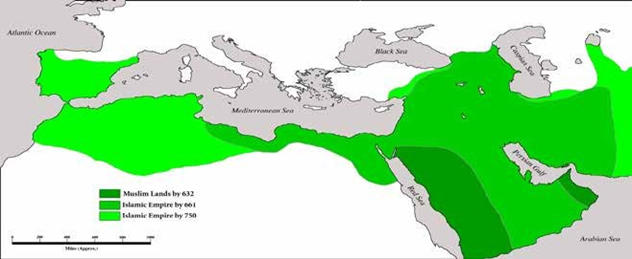It is a matter of great astonishment that despite the fact that Muslim civilization remained a dominant civilization for more than twelve centuries, from Morocco to Indonesia from Central Africa to Russia its followers contributed in improving the lot of humanity. Yet, present day Muslims throughout the world considers their past as dark and shameful. They consider the caliphs and sultans as lustful Harem dwellers, Tyrants, killers and enemy of intellectual scholarship.
Without giving much thought, history of Islamic world is considered similar to European Christian history of dark and middle ages. Little do they know that European Renaissance was heralded by scholars who had been educated at Muslim Spain and Baghdad? Christians and Jews at these centers were highly placed and contributed positively in government and intellectual institutions.
The domain of Islamic system and its political model is spiritual and material, eternal and temporal, this worldly and other worldly, and last but not the least Godly and humanly. Islamic system based society harmonized all the above mentioned aspects in a manner that the Creator and His creation (both human and other creations) embody unity of purpose (Tawhid), i.e., to accept that Allah, the Creator, only has the right to legislate, the creation can only work within the limits set by him. If man acts as his vicegerent (caliph) on earth and makes a governance system within the legislated limits, then harmony is achieved between the Creator and creation.
After the departure of Prophet Muhammad Peace be upon him (pbuh) from this world, Caliphate of Rashidun (Abu Baker, Umar, Usman, Ali, may Allah be pleased with them) was similar to the rule of Saul, David and Solomon (peace be upon them). Except that the lifestyle of Rashidun Caliphs as that of an average Muslim subject. Christians were deprived of that governance system when Saint Paul suspended the law given by Torah and Talmud for the Gentiles, thus Emperor Constantine of Byzantine Empire was not bound by Mosaic Law, and Christianity spread without any temporal governance system at its back. Islamic Caliphates started immediately after the departure of Prophet Muhammad (pbuh), whereas divinely inspired kingdoms of Prophets Saul, David and Salomon reigned after 250 years of Moses’ death.
In this article, a brief review of Muslim caliphates and famous sultanates will be presented. After the conquest of Mecca in 630 AD, Prophet Muhammad (pbuh) was the Caliph of Allah over Arabian Peninsula for two years before he departed from this world. Caliphate of Rashidun reigned for thirty years as predicted by Prophet Muhammad’s (pbuh) hadith, i.e. from 632 to 661. Caliphs in chronological order were Abu Baker, Umar, Usman, Ali bin Abi Talib, Hassan bin Ali (may Allah be pleased with them). Caliphate of Ali was challenged by Governor of As-Sham present day Syria, and remained autonomous during Caliph Ali’s four and a half year rule.
Fifth Caliph designate Hassan bin Ali abdicated in favor of Amir Muawiya bin Abi Sufiyan after losing several battles, so that peace prevails among Muslims. At the end of Rashidun era half of North African coastal regions, Levant, and Southeastern Anatolia came under Muslims. When Amir Muawiya bin Abi Sufiyan, took oath of allegiance from Muslims for his son Yazid as future Caliph, he departed from Islamic principle of Caliphate and converted it into a hereditary process. Thus institution of Caliphate was compromised to a hereditary nomination. Although sharia (Islamic law) prevailed under dynastic Caliphate, but certain political principles were compromised at highest level of governance. Amir Muawiya thus founded the Umayyad Caliphate which lasted from 661 AD till 750 AD. In addition to the Rashidun era annexation, by the end of Umayyad dynasty, all of the North Africa coastal states, Morocco and Iberian Peninsula came under Muslim rule. From Mediterranean Sea till Western Pakistan region and all the central Asians states including Afghanistan also came under Muslim rule.
In 750 AD Abbasid Clan, descendants of Abbas bin Abdul Muttalib, uncle and companion of Prophet Muhammad (pbuh) overthrew the Umayyad rule and took over Caliphate. Their rule was also hereditary. Under caliph Haroon Ur Rashid and Mamoon Ur Rashid, Baghdad reached its zenith of progress and center of intellectual learning of the world.
It is worth nothing that Umayyad dynasty persecuted the Clan of Hashem, especially the supporters of Hussain bin Ali in Medina and Abdullah bin Zubair (grandson of Abu Bakr) in Mecca. Both stood against the hereditary transfer of Caliphate to Yazid bin Muawiya. In turn, when Clan of Abbas took over, they persecuted the notables of Umayyad clan. Yet in both the dynasties, there were rulers who were just, notably, Caliph Umar bin Abdul Aziz of Umayyad dynasty.
Despite these politically motivated persecutions, governance system was progressing, peace was prevalent across Muslim lands, people became prosperous and conquered subjects fared better under Muslim rule than their previous overlords who extracted very high taxes, especially from formers. Even the slaves from the conquests, rose to high position in the caliphs’ Special Forces. Some intelligent female slaves even became mothers of future rulers.
The Abbasids peak, also of Muslim civilization, occurred during the period 786-861 AD. Intellectually, militarily, and governance wise they were the world leaders. Later due to infightings and autonomous rulers, the Caliphate went in decline. Buyids, a Shia Iranian dynasty, which mainly ruled over Iraq and central and southern Iran from 934 to 1062, took over Baghdad. But in 1055, Seljuk General Tughrul under commission from Abbasid Caliph defeated Buyids. Earlier Seljuk Turks swept over central Asia, Afghanistan, Iran, and Eastern Anatolia even Baghdad for a short time. Seljuks were Turk-Persian Sunni in origin and their court language was Persian. They became “defenders of the faith” on behalf of weakened Abbasid Caliphate. The Seljuk dynasty’s decline came at the end of 11th century, due to infighting among heirs ruling different regions; hence the first crusaders from Christian Europe were able to penetrate into Syrian regions. The Seljuk Empire was divided into states in the 12th century; one was ruled by Seljuks and the other by Mamluks (a military caste of former Turk, Kurd and Circassia slaves). The Mamluks occupied Egypt and the holy land until the ottomans took over. The Seljuk dynasty ended with the invasion of the Mongols in 1243. Anatolia surrendered and become a vassal state of the Mongols. In 1258, Hulegu Khan’s Mongol horsemen ransacked Baghdad and ruthlessly killed the Abbasid Caliph Al-Musta’sim.
Earlier, from tenth to twelfth centuries an area including present day Algeria, Tunisia, Sicily, Egypt and Syria came under the rule of the Fatimid dynasty (909-1171 AD) , Ismaili offshoot of Shia sect from north Africa. Their last Caliph died in 1171. Saladin (Salah-ud-din-Ayubi) a vizier in the Fatimid Caliphate became the ruler of Egypt; he realigned Egypt back under Abbasid Caliphate. But in 1241 the last Ayubi sultan was overthrown by Mamluk General and Mamluk dynasty became the next rulers of Egypt and Syria till their defeat by ottoman Turks in 1517.
Ghaznavi dynasty (977 to 1186 AD) ruled at its greatest extent, large parts of Iran, Afghanistan, much of Transoxiana (lower Central Asia) and the northwest Indian subcontinent. Sultan Mahmud of Ghazna’s father Subuktigin was a freed Turkish slave, became a general, and upon his father-in-law’s death became the ruler at Ghazi, Afghanistan. Their strong Sultanate was under suzerainty of Abbasid Caliphate.
In the mid of fourteenth century rose a ruler, Amir Taimur the lame, a Turk, whose war tactics were similar to Genghis Khan. He struck terror in his enemies by executing massacres (killing hundreds of thousands) and destroyed any city which resisted his advance. Due to his terror many non-Muslims were forced to convert to Islam. His rule extended from Levant at the Mediterranean coast, Syria, eastern Anatolia, Iraq, Persia, Georgia, central Asia, Afghanistan, Pakistan and India till Delhi. Samarqand was his capital and after his death in 1405 AD, his Empire was divided among his sons and weakened.
Another region of significance was the Iberian Peninsula. In 711, Muslim forces invaded and in seven years conquered the Peninsula. It became one of the great Muslim civilizations; reaching its summit with the Umayyad Caliphate of Cordoba. Muslim rule ended in 1492 when Grenada was conquered. Andalusia Caliphate, Ottoman Caliphate and Muslim rule in Indian subcontinent and beyond will be dealt with in the next article.
TO BE CONTINUED……










